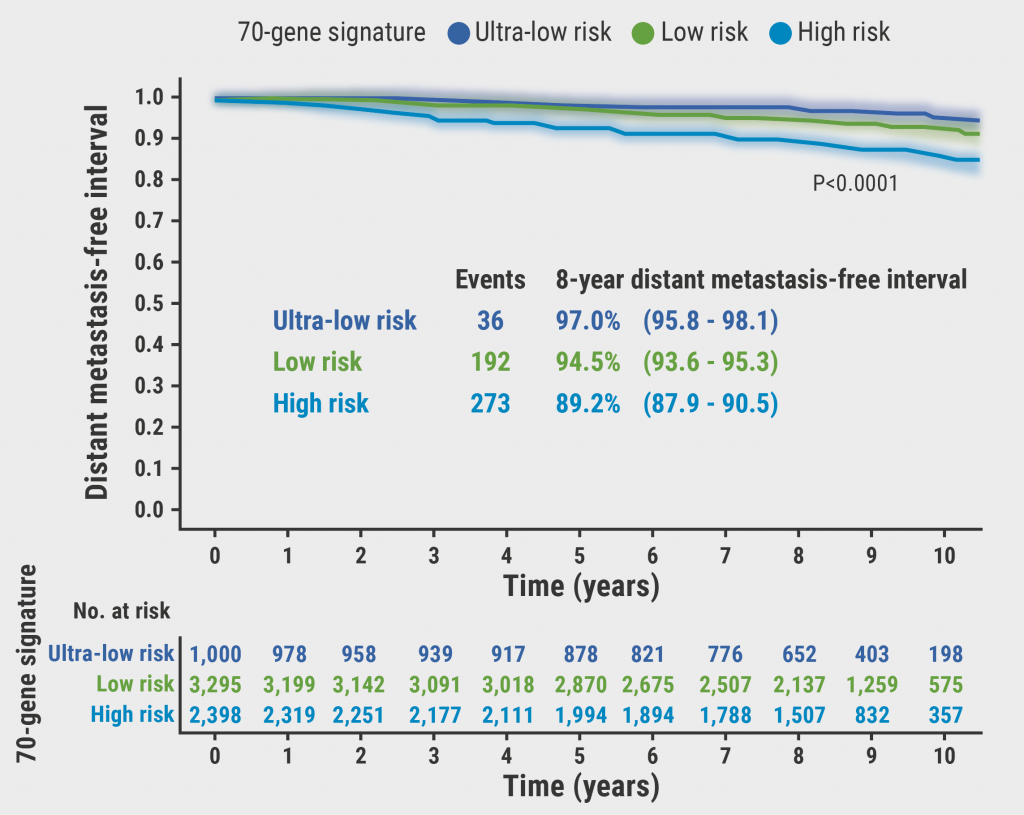Gene signatures have proven successful in identifying patients with a low risk of distant recurrence who could forego chemotherapy [1]. Currently, these signatures are included in international treatment guidelines for breast cancer. For the 70-gene signature (MammaPrint), an additional threshold was established within the low-risk category to identify patients with an ultra-low risk of distant recurrence [2]. In independent cohorts, these patients had excellent breast cancer-specific survival at 15 years, suggesting that ultra-low risk cancers represent indolent diseases [3].
Dr Josephine Lopes Cardozo (Netherlands Cancer Institute, the Netherlands) presented the survival results of patients with an ultra-low-risk 70-gene signature who participated in the randomised, phase 3 MINDACT trial (NCT00433589) [4]. Of the 6,693 patients enrolled, profiling revealed an ultra-low-risk 70-gene signature in 1,000 patients (15%). Among these, 67% were ≥50 years, 81% had tumours <2 cm, 80% were lymph node-negative, 96% had grade 1 or 2 tumours, and 99% were ER-positive. Of patients with an ultra-low risk according to the 70-gene signature, 741 had a low clinical risk and 259 had a high clinical risk. Systemic therapy was received by 83% of patients (69% endocrine therapy, 14% endocrine therapy plus chemotherapy) and 16% received no adjuvant systemic treatment.
After a median follow-up of 8.7 years, 8-year distant metastasis-free interval in the patients with ultra-low risk was 97.0% (vs 94.5% for patients with low-risk signature and 89.2% for patients with high-risk signature; see Figure). Breast cancer-specific survival rate at 8 years was 99.6%, 98.2%, and 93.7%, respectively. The difference in distant metastasis-free interval between patients with ultra-low-risk signature and clinical low risk (n=741) versus ultra-low-risk signature and clinical high risk (n=259) was small: 97.6% versus 95.0%. No difference in breast cancer-specific survival was observed in genomic ultra-low-risk patients by clinical risk: 99.7% versus 99.2%. Distant metastasis-free interval in genomic ultra-low-risk patients who had received no adjuvant systemic treatment was 97.8% versus 97.4% in ultra-low-risk patients who had received adjuvant endocrine systemic therapy and 94.9% in ultra-low-risk patients who had received adjuvant endocrine therapy and chemotherapy.
Figure: Excellent distant metastasis-free interval rates for genomic low-risk and ultra-low-risk patients [4]

Based on these results, Dr Lopes Cardozo concluded that “the 70-gene signature MammaPrint can identify early breast cancer patients who have an ultra-low risk for distant recurrence. These patients could be candidate for further de-escalation of treatment, further reducing overtreatment and the risk of side effects.”
- Piccart M, et al. Lancet Oncol. 2021;22:476-488.
- Esserman LJ, et al. JAMA Oncol. 2017;3:1503-1510.
- Delahaye LJMJ, et al. BC Res Treat. 2017;164:461-466.
- Lopes Cardozo J, et al. Outcome of patients with an ultralow risk 70-gene signature in the MINDACT trial. Abstract 500, ASCO 2021 Virtual Meeting, 4–8 June.
Copyright ©2021 Medicom Medical Publishers
Posted on
Previous Article
« Pembrolizumab benefits survival in MSI-H/dMMR metastastic colorectal cancer Next Article
Molecular tumour profiling impacts the diagnosis and treatment of solid tumours »
« Pembrolizumab benefits survival in MSI-H/dMMR metastastic colorectal cancer Next Article
Molecular tumour profiling impacts the diagnosis and treatment of solid tumours »
Table of Contents: ASCO 2021
Featured articles
Downloadable 1-Page Editor-Selected Trial PowerPoint Slides
Breast Cancer
Excellent prognosis for breast cancer patients with ultra-low-risk gene signature
Olaparib benefits early breast cancer patients with BRCA1/2 germline mutation
Platinum-based adjuvant chemotherapy in TNBC is not superior or non-inferior to capecitabine
Dalpiciclib benefits patients with HR-positive, HER2-negative advanced breast cancer
Trastuzumab-deruxtecan showed clinical activity in patients with brain metastases
Lung Cancer
Neoadjuvant nivolumab plus chemotherapy improves surgical outcomes in NSCLC
Immune-related adverse events are associated with efficacy of atezolizumab in patients with advanced NSCLC
Sustained efficacy of nivolumab/ipilimumab plus 2 cycles of chemotherapy in NSCLC
Patritumab deruxtecan (HER3-DXd) in EGFR TKI-resistant NSCLC
Melanoma
Long-term results from ground-breaking melanoma trials
Novel dual checkpoint blockade improves progression-free survival in melanoma
Neoadjuvant therapy with nivolumab plus relatlimab is safe and effective in patients with stage III melanoma
Genitourinary Cancers
VISION trial shows improved survival with 177Lu-PSMA-617 in mCRPC
Abiraterone added to ADT + docetaxel nearly doubles survival in de novo mCSPC
Post-nephrectomy pembrolizumab improves disease-free survival
Glutaminase inhibitor telaglenastat does not improve survival mRCC
Promising efficacy and safety of feladilimab in recurrent/metastatic urothelial carcinoma
Gastrointestinal Cancers
Pembrolizumab benefits survival in MSI-H/dMMR metastastic colorectal cancer
Panitumumab added to 5-FU/LV effective as maintenance therapy in patients with mCRC
Trastuzumab-deruxtecan showed promising activity in patients with HER2-expressing mCRC
Benefit of both I-O/chemo combo and I-O/I-O combo over chemotherapy alone in oesophageal squamous cell cancer
Benefit of I-O/chemo combo over chemotherapy alone in advanced GC/GEJC/EAC
Perioperative chemotherapy and neoadjuvant multimodality therapy appear equally effective
Haematological Cancers
Olutasidenib demonstrates efficacy in patients with relapsed/refractory IDH1 mutant AML
Acalabrutinib as effective but better tolerated than ibrutinib in CLL
Gynaecological Cancers
Adjuvant chemotherapy does not improve outcome in patients with locally advanced cervical cancer
Novel drug combination for recurrent ovarian cancer
Dual HER2-blockade shows anti-tumour activity in patients with uterine cancer
Paediatric Cancer
Molecular tumour profiling impacts the diagnosis and treatment of solid tumours
Circulating tumour DNA to evaluate response in children with neuroblastoma
Basic Science
PARP7 inhibitor shows promising results in first-in-human trial
IACS-6274 is well tolerated and biologically active in selected advanced tumours
CYT-0851 shows promising anti-tumour activity across different tumour types
© 2024 Medicom Medical Publishers. All rights reserved. Terms and Conditions | Privacy Policy



